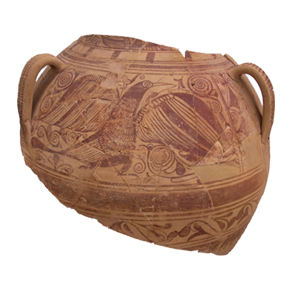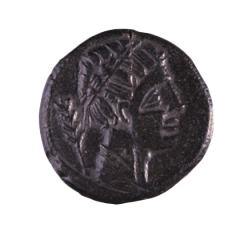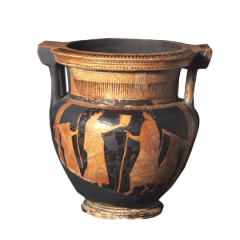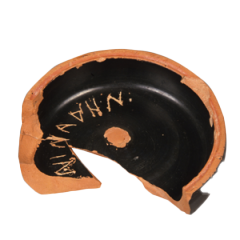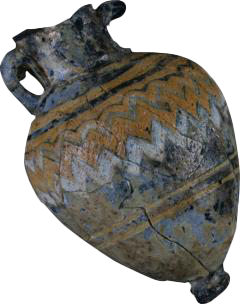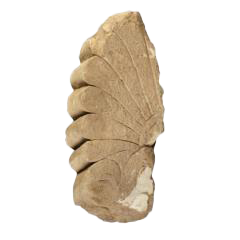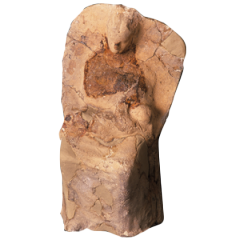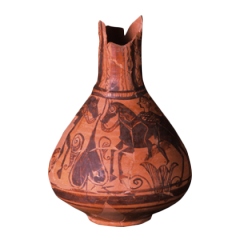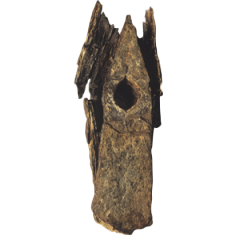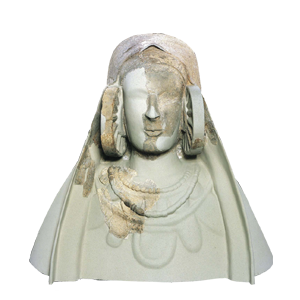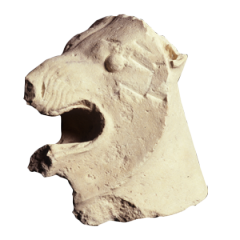
Tap Head
Necropolis of Cabezo Lucero (Guardamar del Segura, Alicante) Limestone h: 27.5 cm; w: 19 cm; d: 23 cm Iberian Second half of the 5th century - beginning of the 4th century BC.
The sculpture preserves a part of the face in which the bulging eyes and the presence of the hair marked by a long stripe on the sides of the head can be seen. The open jaws, with the beak of the upper lip and tongue missing, broken since ancient times, accentuate the impression of fierceness conveyed; small folds of skin have been finely engraved around the mouth and inside the mouth details such as the teeth, some of which are missing, can be seen. The other side of the sculpture is very deteriorated.
In Contestania, the phenomenon of sculpture is usually linked to the funerary world; in the necropolis, some tombs were marked by stele pillars which could be crowned by figures of real animals, such as bulls, or fantastic ones, such as griffins or sphinxes. The griffin, as an inhabitant of the world beyond the grave, is found in funerary monuments as the custodian of the grave goods contained in the tombs; in Greek mythology they are considered to be the guardians of the gold that the Arimaspos are trying to obtain. They are closely related to celestial divinities, appearing in Greek iconography in association with the sun, and Apollo's chariot is often depicted as being pulled by these fantastic beings. For these reasons, their figure is frequently chosen to preside over Iberian tombs, since their apotropaic character is closely related to the celestial divinities.
In the province of Alicante we know of such significant examples as the Grifo de Redován or the one at La Alcudia de Elche. In the 4th century BC, these representations were systematically destroyed, and there are several theories in current historiography that explain this fact, one of the most widely accepted being that which defends the extension of an iconoclastic ideological-religious current.
C. S.: 5732
LLOBREGAT CONESA, E., 1982.
CHAPA BRUNET, T., 1985.
Outstanding pieces in the Iberian Hall
- TINAJA CON DECORACIÓN
ESTILO ELCHE-ARCHENA
Tossal de la Cala (Finestrat).
Cerámica
h: 39 cm; a: 46 cm; e: 30 cm
Iberian
Siglos II-I a.C. - ................................................. Bronze ace from the Iberian mint of Saiti (Xàtiva, Valencia). Type Vives 20-2.
- ................................................. Necropolis of El Cabezo Lucero (Guardamar del Segura) Ceramic h: 34'5cm; w: 29'5 cm Iberian 460-450 BC.
- ................................................. Illeta dels Banyets (El Campello) Ceramic h: 11.2 cm; w: 11.2 cm; d: 2.9 cm Iberian. 380-325 BC.
- ................................................. Necropolis of Cabezo Lucero (Guardamar del Segura) Vitreous paste h: 6.5 cm; w: 4.1 cm: 4'1 cm Ancient Iberian Late 5th century BC.
- ................................................. Necropolis of Cabezo Lucero (Guardamar del Segura, Alicante) Limestone h: 27.5 cm; w: 19 cm; d: 23 cm Iberian Second half of the 5th century - beginning of the 4th century BC.
- ................................................. Necropolis of Cabezo Lucero (Guardamar del Segura)
- ................................................. Necropolis of Cabezo Lucero (Guardamar del Segura) Limestone h: 18.5 cm; w: 8.5 cm; d: 5.3 cm Ancient Iberian-Pliocene Second half of the 5th century-early 4th century BC.
- ................................................. DEMETER-LIKE MOTHER-GODDESS Necropolis of La Albufereta (Alicante) Ceramic made with a univalve mould h: 21 cm; w: 11.3 cm; h: 7.5 cm Iberian 4th century BC.
- Terracotta bust ................................................. Necropolis of La Albufereta (Alicante) Terracotta h: 40 cm; w: 37 cm; d: 21.5 cm Iberian 4th-3rd century BC: 37 cm; w: 21'5 cm Iberian 4th-3rd century BC.
- ................................................. Tossal de Manises (Alicante) Ceramic h: 31.5 cm; w: 21.4 cm Iberian Late 3rd century BC.
- ............................................. La Escuera (San Fulgencio) Iron h: 30 cm; w: 11.4 cm; h: 13.8 cm Iberian 3rd century BC.
- ................................................. Necropolis of Cabezo Lucero (Guardamar del Segura, Alicante) Sandstone) Sandstone h: 49 cm; w: 54 cm; d: 33 cm Iberian Late 5th century BC, early 4th century BC.

